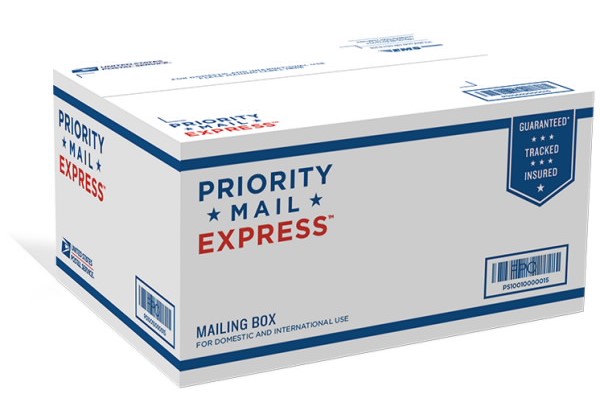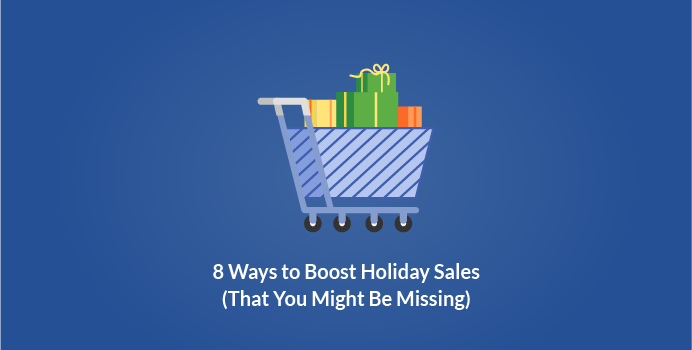As an online seller, you don’t need to be told what the holiday shopping season is like.
It’s a crazy time of year, even for your average Joe. You’re flat out finding gifts for aunts you never see and cousins you don’t actually like.
But if you’re a small businesses owner that’s selling online, you’ve got more problems to add to that list.
Christmas probably isn’t an enjoyable time for you as you’re rushed off your feet. But with a little planning and foresight, there’s a way that Christmas can be much more beneficial to your hip pocket this year.
And in this article, you’re going to see exactly how to do that.
So if you’re really keen to try a few new things this Christmas, and follow those ideas into the New Year, well, you’re in the right place!
1. Get your shipping right
Shipping plays a huge role every Christmas. It’s the only thing that’s stopping your customer from having their purchase right now. You’re able to use shipping to your advantage by figuring out your holiday shipping deadlines.
That is, the absolute latest date that a customer can buy from you and receive their purchase before a certain date.
How can this help you increase your sales?
By developing a sense of urgency. Place a countdown timer across the top of your webpage that counts down to the next ‘cut-off’ date. This banner should tell your customer that they have X amount of time to order if they want their product before Y date.

Bonus tip: If you can afford it, offer international shipping, too. This will allow you to leverage the buying habits in other parts of the world.
2. Can email marketing still work?
Is email marketing dead, or at the least dying?
To answer that question, take a look at your own email inbox, and see how many emails are in there from the last 10 days alone.

That should answer your question—email marketing isn’t going anywhere.
But to make it work for Christmas, you need to write it from an honest place. When something comes from an honest place, there’s trust. When there’s trust, there’s value. Where there’s value, a customer will buy.
In capturing your customer’s email, you should know a few things about your customer – name, email and address, for example. Leverage this. Use your customers’ name throughout the copy of your email wherever possible.
Bonus tip from someone that’s written a lot of marketing emails (me): Write your email as if you’re speaking to one person, not 2398 on your email list.
‘This week we’ve decided that we need to move all these coffee mugs. I don’t know about you Jan, but you can never have too many coffee mugs’.
It’s written as a conversation. It feels natural and, if your customer can relate to it, there’s trust.
Try and learn more about your customer, too.
- How are they using your product?
- What would make your product better?
- Where did they first hear about your product?
These things can help you customize your email to them a little more. As long as an email is relevant (and has value), your reader will engage. Similarly, no one will be interested in your email if all you do it use it to sell.
Sure, selling your product should be one of the things that’s in an email, but it shouldn’t be the only thing that’s in your email.
Tip: Build trust with your customers and make them feel truly valued by including the occasional handwritten thank you note.
3. Reliable and speedy shipping
If you’re not already offering free shipping, do the math to see if you can offer free shipping just for the final few months of the year.
But free shipping isn’t the thing that can help you sell more. Express free shipping is.
Sure, offering free express shipping is expensive if you were to offer it for the entire month of December, so use it sparingly – perhaps an ‘early bird’ incentive offer, as well as the week before December 24th to entice last-minute shoppers.

By offering express free shipping, last-minute buyers can still look at your brand as an option. Free express shipping means that people can buy from you closer to Christmas.
When most online stores have shut their figurative doors and yours is the only option, you’re bound to have a few panicked buyers commit to a purchase.
Give these buyers the best possible buying experience you can, and you’ll have turned some reluctant emergency buyers into return customers.
4. Focus on everything other than Christmas
There are more holidays and events in the last 3 months of the year than in the rest of the year.
Granted, not all of them are as big as Christmas, but most of them can be leveraged by your brand in order to increase attention, and ultimately, sales.
Take, for example, November 11th. In the US, UK and many other ‘Western’ countries, it’s a day of remembrance and mourning.
In Asia, it’s a day called ‘Singles Day’. A day where people without a significant other are celebrated, flattered, and given gifts.
On Singles Day 2017, Alibaba sold over $25 billion worth of product.
$25 billion. Let that number sink in for a minute. In one day, Alibaba made an amount of money that’s comparable to the GDP of Iceland. So it’s safe to say that this holiday is big in Asian communities.
How can you leverage this engagement?
Consider paying attention to these smaller events to get in front of a more niche audience and get involved with Singles’ day—particularly if you find you ship to Asian countries on a regular basis.
Also, consider days like:
- Small Business Saturday (December 1)
- Cyber Monday (November 29)
- Hanukkah (December 2-10)
- St Nicholas Day (December 6th)
- Free Shipping Day (December 14)
5. Bring customers back for a second experience
It costs between 4 and 10 times as much to convert a new customer than it does to keep a current one.
The point here is that more often than not, we only gauge success by the number of customers we have. Try refocusing your marketing efforts on your return customers to gain repeat business.
They’ve bought with you in the past, so get them to buy from you again!
As the only saying goes, it’s 20% of your customers that make 80% of your revenue, so you’d do no harm trying to increase this 20%. This can be as simple as a discount code. Send a return customer a bit of an incentive to buy from you again. This is something that can easily and automatically be done using ShippingEasy’s Customer Marketing tool.
Other tips when trying to reactivate buyers:
- Use personalization such as their name and when/what they last bought
- Send them a gift—an Amazon card—everyone has an Amazon account and wants something
- Surprise them on their birthday with a little present of some kind
It’s not hard to think of a reason to get in contact with someone you haven’t heard from in a while – and your customers should be no different!
6. Customer marketing
Customer marketing is a relatively unheard of term. It can be summed up by saying that it’s the way you get your customers to do your marketing for you.
That doesn’t mean that you take a happy customer on board as an employee. It simply means encouraging your customers to share their thoughts and experience with your brand amongst others.
This is a broad term and includes concepts like word-of-mouth marketing and influencer marketing. The concept is effective for the same reason that testimonials are. It’s a real person talking about your brand, your product, and what it’s like to be the owner of your product. Often, people just need a nudge, which can be as simple as sending a follow-up email asking for a review or social share. Customer marketing has the added advantage of also helping you reconvert previous customers through product recommendations, repurchase suggestions, and follow-up emails.
Plus, in working closely with your past customers, you’re able to see firsthand how they use your product to solve problems, and what other problems they may have.
7. Monitor inventory
The last thing you want to do in the lead up to Christmas is to email a customer saying ‘Hey, you know that thing you bought? Yeah, we don’t actually have it’.
This is not only going to anger that one customer but will probably result in sharing the bad news in the form of a review or social post. As we all know, bad news travels faster than good news.
Lucky, all this can be avoided by using an inventory management system. Now, you might be thinking “my e-commerce platform already monitors my sales.”
You get a sale and you change the number. That’s great if you’re selling in just your online store.
But what if you’re selling in your Shopify web store, as well as Amazon? What if you’re selling on your web store and Amazon and Etsy and in a retail store?
You’ve got a lot of sales channels, and probably a lot of sales – and that means there are more opportunities for you to have a little numerical accident.
By using inventory management software that’s specifically designed for multichannel sales, you minimize the chances of selling something you don’t have in stock. You also make it easier to update specific product details over multiple channels.
How else can you avoid this?
Do a regular stock take. Depending on your number of SKUs, you may find it valuable to do a stock take every week.
As you start to move more product, go out and check whether what’s on your shelves matches what’s in the system.
8. Focus on another product
Believe it or not, you’re able to sell more of your own product by drawing the attention of your customers to another brand’s product.
What problems does your product solve?
If you’re selling fashion, it may solve the ‘price’ problem – quality fashion that doesn’t cost an arm and a leg. On the other end of the scale, you may sell handmade lingerie that feels incredible.
Either way, your products solve problems and have unique selling points.
Ask yourself the following:
What other products solve similar problems to the one that mine solves?
Chances are that there are complementary products out there for your brand.
Here are just a few examples:
- High-end steak knives – quality skillet fry pans
- Dog collars – outdoor gear
- Gym clothing – supplements
For everything you sell, there’s a product you don’t sell that can help your product. This holiday season, reach out to a brand that sells a complementary product of a similar quality and work together.
This will expose you to each others’ audience. The extra benefit is that the other audience is more likely to use your product, as they use a complementary product, too.
How will you boost holiday sales this season?
Granted, the ideas presented in this article will only add to your workload in the craziest time of the year. But each idea may also add to your profits this year. Remember that like most things in the world of marketing, it’s important to A/B test. Implement the idea, measure it, and then assess if it was worthwhile.
Don’t be afraid to walk away from something if it doesn’t work. With a good plan, some of these strategies may be worthwhile carrying over into the New Year!
Guest author Phil Forbes
I’m a bearded Australian living in Warsaw, Poland. Digital marketer at Packhelp, who enjoys helping and watching small ventures start, learn, grow and thrive. I take care of expatspoland and love my dog, Star Wars, heavy metal and my girlfriend – in no particular order.

Jack Ship
Latest posts by Jack Ship (see all)
- E-Commerce Shipping Solutions You Should Consider for Your Site - February 28, 2021
